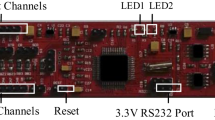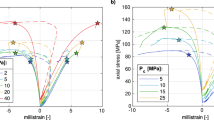Summary
Stress measurements can be performed with the, measuring principle for a flat jack discussed in this paper without any material parameters of the flat jack being of influence. This means that no calibration measurements are required by this flat jack for absolute measurements and there is no dependence on temperature. It is called “Absolut Widerstands Druckmesskissen” or short AWID-Flat Jack.
Basis of evaluation is a change in the electrical resistivity of the flat jack, which is caused by two metal sheets separating from each other when inflated with hydraulic oil as soon as the external pressure is reached.
Besides theoretical considerations concerning the mode of operation of the flat jack, this paper presents laboratory measurements performed in an autoclave as well as in a tube filled with salt grit under a uniaxial press. Changes of stress can be measured if the flat jack is cemented into a borehole under initial stress. The absolute stress of the bedrock can be measured after a certain time of adjustment in rock capable of creep (salt, clay, etc.).
The advantages of the AWID measuring system are confirmed by in situ-measurements in a salt pillar loadable with variable pressure.
In a temperature experiment at the Asse salt mine (Federal Republic of Germany) where the salt was heated up to 200°C, the advantages of the AWID measurement system were confirmed.
Similar content being viewed by others
References
Albers, G. (1982): Unveröffentlichte Rechnungen zum Temperaturersuch 6. Inst. f. Elektrische Anlagen der TU Aachen.
Albrecht, H., Hunsche, U. (1980): Gebirgsmechanische Aspekte bei der Endlagerung radioaktiver Abfälle in Salzdiapiren unter besonderer Berücksichtigung des Fließverhaltens von Steinsalz. Fortschr. Miner.58 (2), 212–247.
Amadei, B., Goodman, R. (1982): The Influence of Rock Anisotropy on Stress Measurements by Overcuring Techniques. Rock Mechanics15, 167–180.
Dreyer, W. (1974): Gebirgsmechanik im Salz. Stuttgart: Ferdinand Enke.
Dürr, K., Korthaus, E., Donath, P. (1979) Untersuchungen zur Temperaturentwicklung bei der Endlagerung hochradioaktiver Abfälle, Teil II. Atomwirtschaft—Atomtechnik24, 2.
Flach, D., Frohn, C., Hente, B., Schmidt, E., Taubert, D. (1983): Hydraulic Fracturing Experiments in Salt Rock with Seismic Fraclocation Field Measurements in Geomechanics. International Symposium, Switzerland, Sept. 5–8.
Haimson, B. C. (1982): Deep-hole Pre-excavation Stress Measurements for the Design of Underground Powerhouses in the Sierra-Nevada Mountains. ISRM Symposium, Aachen.
Herget, G. (1973): First Experiences with the C. S. I. R. Triaxial Strain Cell for Stress Determination. Int. J. Rock Mech. Min. Sci. & Geomech. Abstracts10, 509–523.
Hoskins, E.R. (1966): An Investigation of the Flat Jack Method of Measuring Rock Stresses. Int. J. Rock Mech. Sci.3, 249–264.
Hunsche, U., Plichke, I., Nipp, H.-K., Albrecht, H. (1985): An In Situ Creep Experiment Using a Large Rock Salt Pillar. Proc. 6th Int. Symp. on Salt, Toronto, Ontario, Canada.
Kessels, W., Flentge, I., Kolditz, H., Muth, M. (1983): AWID, ein absolut messendes Druckkissen nach dem Kompensationsverfahren. GSF-Bericht, GSF-T 174.
Kessels, W. (1984): Thermomechanical Calculations and Constructional Criteria for an In Situ Test on the Cracking of Salt Induced by High Thermal Power. Proc. Joint CEC/NEA Workshop on “Experiments in Underground Laboratories”, May 15–17, GSF-T 182.
Kessels, W. (1984): Testing of an Absolute Measuring Flat Jack. Proc. Joint CEC/NEA Workshop on “Experiments in Underground Laboratories”, May 15–17, GSF-T 185.
Kessels, W., Flentge, I., Kolditz, H. (1985): D. C. Geoelectric Soundings for Determining Water Content in the Salt Mine Asse (F-R. G.) (1985). Geophys. Prospecting33, 436–446.
Kessels, W.: AWID Stress Measurements. — Results of Temperature Test 6 in the Asse Salt Mine. — EUR-Report 1986, to be published.
Langer, M. (1982): Felsmechanische Probleme bei der Errichtung von Speicherkavernen. ISRM Symp., Aachen.
Leeman, E. (1968): The Determination of Complete State of Stresses in Rock in a Single Borehole Laboratory and Underground Measurements. Int. J. Rock Mech. Min. Sci.5, 31–57.
Natau, O. (1970): Ein praktisch verformungsfrei messendes Element zur Bestimmung von Spannungen im visko-elastisch-plastischen Gebirge. Sitzungsbericht des 2. Kongresses der Internationalen Gesellschaft für Felsmechanik, Belgrad, Bd. 4.
Rummel, F., Baumgärtner, J., Alheid, H.J. (1983): Hydraulic Fracturing Stress Measurements Along the Eastern Boundary, of the SW-German Block. U.S. National Committee for Rock Mechanics. Annual Review of U.S.Progress in Rock Mechanics—Rock Mass Characterization, Washington, D. C.
Wallner, M., Wulf, A. (1982): Thermomechanical Calculations Concerning the Design of a Radicactive Waste Repository in Rock Salt. ISRM Symposium, Aachen.
Author information
Authors and Affiliations
Rights and permissions
About this article
Cite this article
Kessels, W. Operational principle, testing, and applications of the AWID-flat jack for absolute stress determinations using voltage measurements. Rock Mech Rock Engng 19, 165–183 (1986). https://doi.org/10.1007/BF01024954
Issue Date:
DOI: https://doi.org/10.1007/BF01024954




